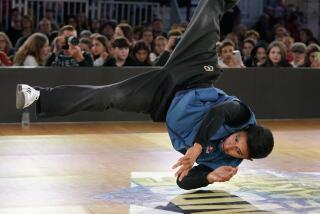In Good Standing
- Share via
SANTA BARBARA — Thousand Oaks student Eric Weber watches the horse canter around the arena, nods his head in time to its gait and chooses his moment.
In one terrifying leap, he flings himself onto the moving horse, unfurls into a handstand and then stands up, arms stretched like wings, as the elegant horse continues to prance.
Weber, 19, is one of the country’s top competitors in vaulting, a little-known equestrian sport, which Weber’s coach describes as a gymnast’s balance-beam routine performed on a moving target.
Those skills will be on display today through Sunday in Santa Barbara, as the American Vaulting Assn. holds its national championships. Weber is one of 205 competitors who will take part in the free public exhibitions at the Earl Warren Showgrounds. His mother, Jan, is vice president of the association and, along with her husband Bob, helped organize the event.
Members of the Barronsgate Vaulting Club of Agoura Hills, which recently represented the United States in the World Vaulting Championships in Germany, will perform with Weber and others at a benefit dinner at 4:30 p.m. Saturday at the show grounds.
Traced to ancient Greece, when skillfully vaulting off a horse in battle meant the difference between life and death, the modern sport features highly stylized movements performed to music.
Competitors vault alone or in teams of eight that perform dazzling acrobat-style routines, three at a time, on horseback. Vaulters like Weber train for years to advance to the national level.
He started when he was 12, after tagging along with his sister to her riding lessons. Vaulting looked more fun to him than riding, he said, and soon he was putting in 15 hours a week practicing gymnastics, running and taking care of his club’s horse.
He also found he loved preparing for his brief competitions, which he calls “the hardest minute of work you’ll ever do.”
*
Weber, a junior majoring in bioengineering at UC Berkeley, trains with Emma Drinker, 41, at the Mt. Eden Vaulting Club in Saratoga, about 50 miles south of San Francisco.
The sport’s dangerous appearance is misleading, said Drinker. Some schools encourage young riders to learn vaulting first, she said, because the trainer--instead of the rider--controls the horse. That is safer for inexperienced riders, she said, leaving them free to learn balance.
Vaulters spend hours training on mats and on stationary barrels before working with a horse, Weber said. When they finally try their routines on horseback, the only remaining challenge is staying on.
“You fall off a lot,” Weber said. “It becomes about trusting yourself and trusting the horse.”
The sport draws people with disabilities who could not otherwise ride a horse, said Charles Bittenbring, president of the American Vaulting Assn. It also attracts youths who love horses but could never afford pricey riding lessons, he said, because all the kids in a vaulting club--usually 12 to 30 members--share the cost of a horse and trainer.
On average vaulters pay $50 to $120 per month for their sport, he said.
About 750 people, mostly youths age seven to 18, belong to the national association, Bittenbring said.
*
Enthusiasts from across the country are expected for this weekend’s event. On Wednesday Weber practiced in an arena while vaulting clubs from all over the country backed in their horse trailers, inspected their gear and tweaked their routines one last time.
A tinny recording of John Williams’ theme to “Raiders of the Lost Ark” floated out from a far corner of the show grounds.
Weber rode, Rusty, a broad-backed tank of a horse strong enough to hold three vaulters. Rusty was led around the ring by Lisa Jackson, 20, of Cupertino.
Any horse will do for the sport, as long as it can support a pile of gymnasts whipping around on its back, is patient and doesn’t stop when someone walks up beside it, as most horses are trained to do.
Some horses take to vaulting, learning to help their riders balance--but some don’t, Drinker said. It’s easy to distinguish the ones that learn quickly.
“You can have a horse who is a complete bozo for riding, but you put them in vaulting and they say, ‘OK, this makes sense to me,’ ” she said.
Watching Weber on Wednesday as he rounded the practice arena atop Rusty, Drinker shouted out instructions. Since Weber has been ranked among the sport’s top 10 competitors for the past few years, he needs little but fine-tuning.
“You look good,” Drinker told him as he caught his breath after practice. “You ready?”
“Ready,” Weber said.
More to Read
Go beyond the scoreboard
Get the latest on L.A.'s teams in the daily Sports Report newsletter.
You may occasionally receive promotional content from the Los Angeles Times.






